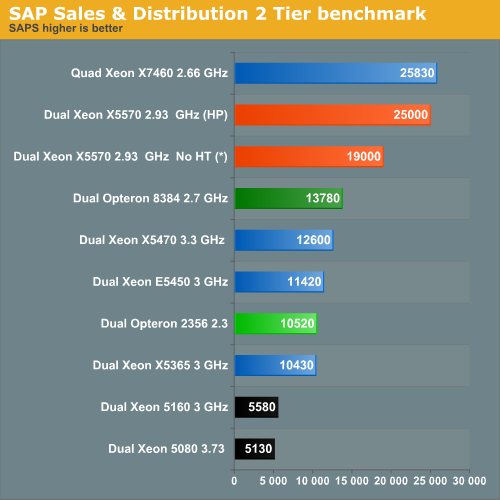The Best Server CPUs part 2: the Intel "Nehalem" Xeon X5570
by Johan De Gelas on March 30, 2009 3:00 PM EST- Posted in
- IT Computing
ERP benchmark 1: SAP SD
The SAP SD (sales and distribution, 2-tier internet configuration) benchmark is an interesting benchmark as it is a real world client-server application. We decided to take a look at SAP's benchmark database. The results below are 2-tier benchmarks, so the database and the underlying OS can make a difference. It is best to keep those parameters the same, although the type of database (Oracle, MS SQL server, MaxDb or DB2) only makes a small difference. The results below all run on Windows 2003 Enterprise Edition and MS SQL Server 2005 database (both 64-bit). Every "2-tier Sales & Distribution" benchmark was performed on SAP's "ERP release 2005".
In our previous server oriented article, we summed up a rough profile of SAP S&D:
- Very parallel resulting in excellent scaling
- Low to medium IPC, mostly due to "branchy" code
- Somewhat limited by memory bandwidth
- Likes large caches (memory latency!)
- Very sensitive to sync ("cache coherency") latency

(*) Estimate based on Intel's internal testing
If you focus on the cores only, the differences between the Xeon 55xx "Nehalem" and the previous generation Xeon 54xx "Harpertown" and Xeon 53xx "Clovertown" is relatively small. The enormous differences in SAP scores are solely a result of Hyper-Threading, the "uncore", and the NUMA platform. According to SAP benchmark specialist Tuan Bui (Intel), enabling Hyper-Threading accounts for a 31% performance boost. Using somewhat higher clocked DDR3 (1066 instead of 800 or 1333 instead of 1066) is good for another 2-3%. Enabling the prefetcher provides another 3% and the Turbo mode increased performance by almost 5%. As this SAP benchmark scales almost perfectly with clock speed, that means that the Xeon X5570 2.93GHz was in fact running at 3.07GHz on average.
Consider the following facts:
- The quad-core AMD Opteron 8384 at 2.7GHz has no problem beating the higher clocked 5470 at 3.3GHz.
- It is well known that the Xeon 54xx raw integer power is a lot higher than any of the Opterons (just take a look at SPECint2006).
- Faster memory and thus bandwidth plays only a minor role in the SAP benchmark.
- SAP threads share a lot of data (as is typical for these kind of database driven applications).
It is clear that synchronization (between L2 caches) that happens in the L3 cache, the fast inter-CPU synchronization that happens via dedicated interconnects, is what made the "native quad-cores" of AMD winners in this benchmark. Slow cache synchronization is probably the main reason why the integer crunching power hidden deep inside the "Harpertown" cores did not result in better performance.
Take the same (slightly improved) core and give it the right (L3 as quick syncing point for the L2s) cache architecture and NUMA platform with fast CPU interconnects and all that integer power is unleashed. The result is the Nehalem X5570 Xeon is clock for clock about 66% faster than its predecessor (19000 vs. 11420). Add SMT (Simultaneous Multi-Threading) and you allow the integer core to process a second thread when it is bogged down by one of those pesky branches. The last hurdle for supreme SAP performance is taken: The eight core "Nehalem" server is just as fast as a 24 core "Dunnington" and 80% faster than the competition.
AMD has just launched the Opteron 2389 at 2.9GHz. We estimate that this will bring AMD's best SAP score to about 14800, so Nehalem's advantage will be lowered to ~70%. Unfortunately for AMD, that is still a very large advantage!










44 Comments
View All Comments
usamaah - Monday, March 30, 2009 - link
Is it me or is page 2 of this article missing some information? The title of that 2nd page is "What Intel and AMD are Offering," but in the body of the text there are only descriptions of Intel's Xeon chips? Perhaps a new title to reflect the body, or add AMD info?JohanAnandtech - Monday, March 30, 2009 - link
I moved the AMD vs Intel pricing data to the back of the article as the pricing info is more interesting once you have seen the results. But forgot to change the title.. fixed. Thanks.usamaah - Monday, March 30, 2009 - link
Cool, thank you. Next time I'll finish reading the article before I make a comment, sorry ;-) Anyway wonderful article.Ipatinga - Monday, March 30, 2009 - link
Very nice to see a comparison over some generations of Xeon platform, including the new one (yet to be released).I would like to see a new article with Core i7 vs Xeon 5500... to check out if my Core i7 @ 3,7GHz is good enough in Maya 2009 (Windows XP 64bit, 12GB DDR3), or if a Xeon 5500 (each at 2,4GHz, for instance) in dual processor configuration will be a much better buy.